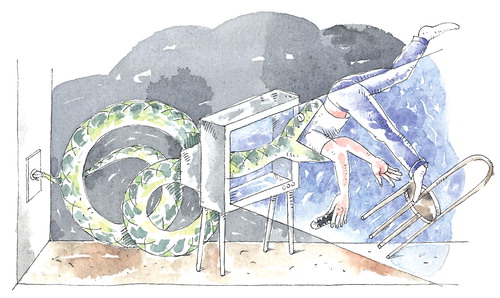TV Major Activity for Youngsters Before They Reach Age 1
Frequent television viewing in adolescence may be a risk factor for attention and learning problems—and American children are watching a lot of television.
Those are findings from two separate studies in the May Archives of Pediatric and Adolescent Medicine.
In one of those reports, a telephone survey of 1,009 parents of children aged 2 months to 24 months, found that approximately 40 percent of 3-month old children and about 90 percent of children age 24 months and under regularly watch television, DVDs, or videos,
The median age of initiating viewing was 9 months. The average amount of viewing time for the children was 40.2 minutes a day. At 3 months of age children watched less than an hour a day, and by 24 months they watched more than 1.5 hours a day.

“Approximately half of the viewing was of shows that parents reported to be in the children's educational category,” wrote Frederick Zimmerman, Ph.D., of the University of Washington, Seattle, and colleagues, in the report. “The remaining half was approximately equally split among children's noneducational content, baby DVDs/videos, and grown-up television.”
The study analyzed four television and DVD content categories: children's educational, children's noneducational, baby DVDs/videos, and grown-up television (such as talk shows or sports programming). Also reported were average daily viewing amounts, reasons parents gave for their child's viewing, who was present during viewing, and sociodemographic factors.
Zimmerman and colleag ues also reported that compared with children without siblings, children with two or more siblings were less likely to view grown-up television and watched about 18 minutes less a day in all content types.
“These results suggest that it may not be only the amount or content type that children view, but also the role of siblings in helping to process this content that may affect whether television viewing helps or hinders development,” the authors conclude.
The other study in the same issue of the Archives suggests that all that television viewing may be related to later attention and learning difficulties.
Teenagers who watch television for three or more hours a day may have a higher risk of attention and learning difficulties in their adolescent and early-adult years, wrote Jeffrey Johnson, Ph.D., of Columbia University College of Physicians and Surgeons and the New York State Psychiatric Institute, and colleagues.
They studied 678 families in upstate New York. Parents and children were interviewed about television habits and school problems three times between 1983 and 1993, when the children were an average of 14, 16, and 22 years old. Between 2001 and 2004, when the children in the study had reached an average age of 33, they provided information about their secondary and postsecondary education, including whether they graduated from high school or attended college.
At age 14, 225 (33.2 percent) of the teens reported that they watched three or more hours of television a day. “Television viewing time at mean age 14 years was associated with elevated risk for subsequent frequent attention difficulties, frequent failure to complete homework assignments, frequent boredom at school, failure to complete high school, poor grades, negative attitudes about school (i.e., hates school), overall academic failure in secondary school, and failure to obtain postsecondary (e.g., college, university, training school) education,” the authors wrote. “These associations remained significant after the covariates were controlled.”
The researchers also conducted 14 analyses to investigate associations between attention and learning problems at age 14 and subsequent television habits. Only two of these analyses suggested any association, indicating that television watching contributes to learning difficulties and not vice versa.
“The results suggest that although youths with attention or learning problems may spend more time watching television than do youths without these difficulties, this tendency may be unlikely to explain the preponderance of the association between television viewing and attention and learning difficulties during adolescence,” they wrote.
An abstract of “Television and DVD/Video Viewing in Children Younger Than 2 Years” is posted at<http://archpedi.ama-assn.org/cgi/content/abstract/161/5/473>. An abstract of “Extensive Television Viewing and the Development of Attention and Learning Difficulties During Adolescence” is posted at<http://archpedi.ama-assn.org/cgi/content/abstract/161/5/480>.▪
Credit: Sergey Ivanov



